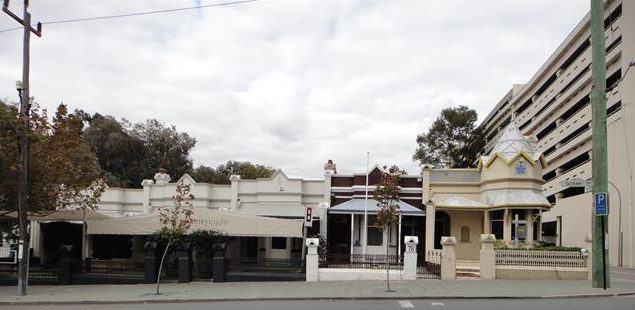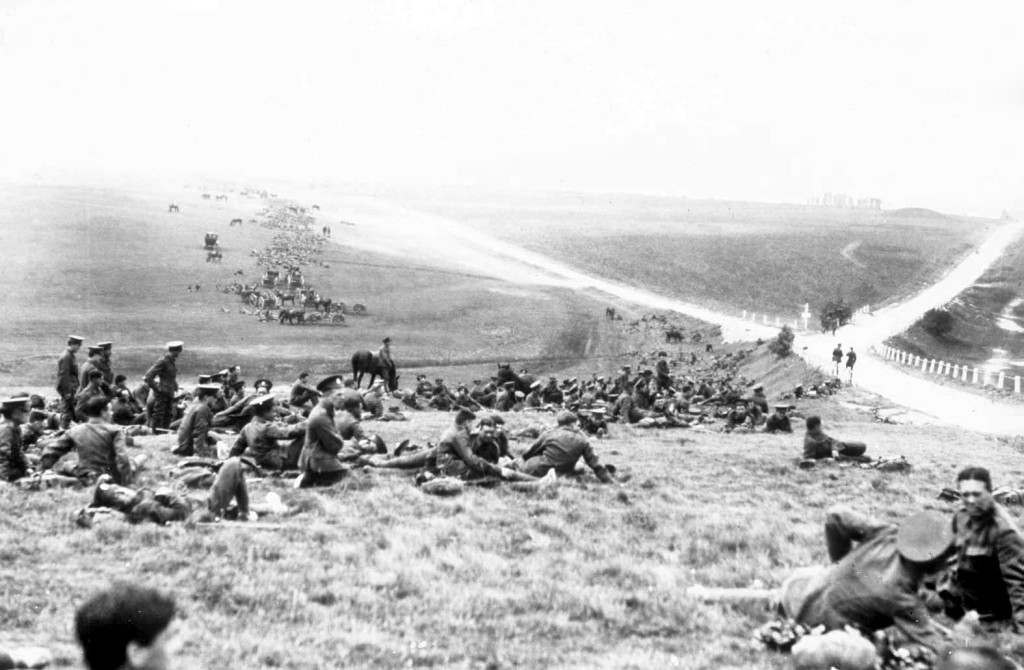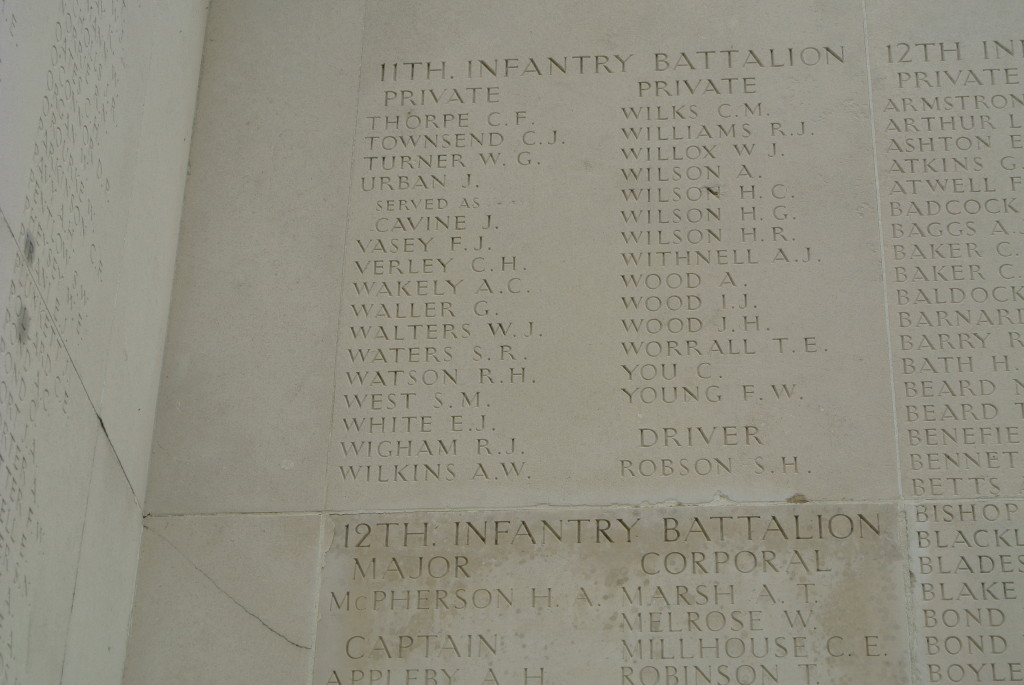When Sydney Waters left London on 1st December 1916 for a new life in Australia it is unlikely that he expected to be back in England eight months later as part of the Australian Imperial Force.
Sydney (Sidney) was born in Blofield, Norfolk in June 1890. He was the youngest child of Alice and James Waters. He had four sisters and a brother. Florence was born in 1876, Edith in 1883, Basil in 1885, Mabel in 1887 and Nesta in 1889.When Sydney was born his parents were living in Blofield and his father was working both as a farmer and a coal merchant. In 1897 they moved to live in Saxlingham Nethergate, where James worked as a pork butcher. He is later recorded as being a market gardener. Sydney and his sister Nesta were registered in the Church school in Saxlingham on 18th May 1897. By 1901 Nesta was living with her married sister Florence in Suffolk. Sydney left school in 1903 aged 13 years old. What he did between leaving school and travelling to Australia in 1916 is not known. So far it has not been possible to find out where he was in 1911.
On 1st December 1916 he left London on SS Osterley of the Orient Line for Fremantle in Western Australia. He was aged 25 years and gave his occupation as cook. The journey to Australia would have taken at least eight weeks, so he would have arrived there about the beginning of February 1917. On the 20th April 1917 he enlisted in the Rifle Corps of the Australian Imperial Force. He had been in Perth only about two and a half months before he decided to join the army. Did he not like Australia? Did he miss England? Could he not find work? We will never know.
At the time of enlisting he gave his address as 82 Outram Street, West Perth and his occupation as cook. In the early 20th century many of the houses in Outram Street were large and occupied by wealthy merchants or politicians. 82 Outram Street was part of terrace of smaller single storey houses. The property is now a listed building of historic interest though no longer used for residential purposes. It is assumed that Sydney was working there as a cook or perhaps living there as a lodger.

Outram Street, 2011. Photographer, Sian Ferrez, Heritage Council of Western Australia.
82 Outram Street is at the extreme left of the terrace and is now part of a restaurant
At his medical he was described as being 5 feet 6 inches tall and he weighed 9 stones. He had a fair complexion, blue eyes and brown hair and a scar on his forehead. He joined the Rifle Corps, 11th Battalion, 26th Reinforcement, Australian Imperial Force. His regimental number was 7815.
The next two months were spent training before he embarked from Fremantle on 29th June 1917 aboard HMAT Borda. The ship arrived in Plymouth on 25th August 1917. He was then stationed at a camp at Durrington, Wiltshire where he continued his training until 7th November 1917.
He was then transferred to the 2nd and 5th Camps at Sutton Veny. Whilst at Sutton Veny he was admitted into the military hospital for seven days with a swollen knee.
At the beginning of 1918 he was considered to be trained, and fit enough to join the forces in France. He left for France from Southampton on 8th January 1918 arriving at Le Havre the next day. He remained at the Australian base camp at Le Havre until 22nd January when he was transferred to the unit on the front line.
In early 1918 the Germans started a spring offensive and managed to push the allied forces back. The 11th Battalion was involved in the fighting which resulted in the German forces’ advance being stopped. As a result of retreating the German front lines lacked fortifications and were not continuous. The Australian units took advantage of this and from April started operations known as “peaceful penetration”. Small groups of men infiltrated the German lines from behind. The aim was to take prisoners, reconnoitre, and take over outposts. They were very successful and it affected German morale. The forays inevitably resulted in casualties. However during the summer months the Australian Forces also took part in more important attacks upon the enemy.
By the end of May the Australians were holding the front line near Merris. On the night of 2nd June 1918 the 11th Battalion, as part of the 3rd Brigade, was involved in an attack upon Mont de Merris. The German defences were in old trenches originally dug by the British and situated on top of a ridge overlooking the village of Merris.
The operation was carefully planned. The German trenches were very close to the Australian lines and so the troops assembled silently to take the Germans by surprise. The troops wore white arm bands so their positions could be seen. This was to avoid their being hit, as had happened on another occasion, by ‘friendly fire’. The barrage began at 1 o’clock in the morning of 3rd June1918. The troops moved forward in file preceded by riflemen. They successfully took the German trenches and outposts. They continued to come under fire for some time from German machine gun posts situated further away. By 3.30 in the morning of 3rd June the front line was quiet and the German trenches had been taken. Four officers and eighty seven men of the 11th Battalion were killed during the battle. One of these men was Sydney.
Like many other men he has no known grave. He is remembered on Panel 64 on The Australian National Memorial, Villers-Bretonneux, France.
His effects were received at the Army headquarters in London on 24th July 1918 and forwarded to his father, James Waters, who was named as beneficiary and executor of his will. These included a YMCA wallet, letters, curios, and photographs. However his father, James, had died the day after his son on 4th June 1918 aged 69 years. Nesta Kate Waters, Sydney’s sister, therefore dealt with the administration of his will. Sydney left effects of £120 17s.
He was awarded the British war medal and the Victory medal. A memorial scroll was sent to his family in November 1922.
Acknowledgements
Census records: 1881, 1891, 1901, 1911
British Army WW1 Medal Rolls Index Cards 1914-1920
Saxlingham Nethergate School log book.
National Archives of Australia- Service records
Papers from Saxlingham Nethergate Church Chest now deposited at Norfolk Record Office.
England and Wales, National Probate Calendar (Index of Wills and Administrations) 1858-1966
Wikipedia-Outram Street, and Peaceful penetration.
Don’t forget the Diggers: Photograph of Le Havre Base Camp
www.dance-family.com : Photograph of ward in Sutton Veny Military Hospital
David Healing. Durrington : Photographs of camps and commonwealth soldiers.
www.static.awm.gov.au /images/collection :The A.I.F in France. Chapter XI (14th May – 2nd June1918)
Heritage Council of Western Australia. Photograph of Outram Street, 2011, photographer Sian Ferrez







